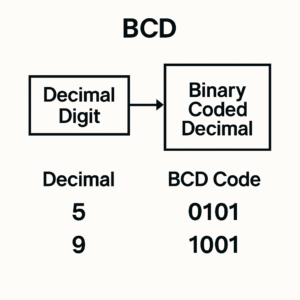What is BCD Code? – Explained in Simple Terms
BCD stands for Binary Coded Decimal.
It is a method of converting decimal numbers into binary form, where each decimal digit is represented by a 4-bit binary number.
In short: BCD represents each digit of a decimal number using binary code.
BCD is widely used in digital electronics, calculators, and early computer systems. It helps convert human-readable numbers into a format that computers and digital circuits can understand.
🔸 How Does BCD Work?
In BCD, each decimal digit (0–9) is converted into a 4-bit binary number, based on a simple truth table.
📌 Example:
The decimal number 123 is converted into BCD like this:
-
1→0001 -
2→0010 -
3→0011
👉 So, 123 in BCD is: 0001 0010 0011
🔸 BCD Truth Table
| Decimal | BCD |
|---|---|
| 0 | 0000 |
| 1 | 0001 |
| 2 | 0010 |
| 3 | 0011 |
| 4 | 0100 |
| 5 | 0101 |
| 6 | 0110 |
| 7 | 0111 |
| 8 | 1000 |
| 9 | 1001 |
📌 Any number with digits beyond 9 (like 10, 11, 15…) is not allowed directly in BCD.
🔸 Types of BCD
BCD is mainly divided into two types:
1. Unpacked BCD
-
Each byte stores only one digit of a number.
-
For example, the number
5would be stored as0000 0101.
2. Packed BCD
-
Each byte stores two digits.
-
For example, the number
45would be stored in one byte:0100 0101.
🔸 Advantages of BCD
-
✅ Easier to decode than binary.
-
✅ Used in computers, digital clocks, calculators, etc.
-
✅ Useful in digital communication systems.
🔸 Disadvantages of BCD
-
❌ Arithmetic operations (like add/subtract) are more complex.
-
❌ Needs more memory than binary to store numbers.
-
❌ Not as efficient as pure binary.
-
❌ Takes up more bits per digit.
-
❌ Slower and harder for computers to process.
🔚 Conclusion
BCD is a helpful way to represent decimal numbers using binary, especially in electronic systems that interact with humans. It’s simple to understand and easy to decode, but not very efficient for large computations. Still, BCD plays a key role in digital electronics and basic computer logic.
BCD Code in Hindi – बीसीडी कोड क्या है?
- BCD का पूरा नाम Binary Coded Decimal (बाइनरी कोडेड डेसीमल) होता है। यह एक ऐसी प्रक्रिया है जिसमें प्रत्येक डेसीमल संख्या (decimal number) को बाइनरी संख्या (binary number) में बदल दिया जाता है।
- BCD एक प्रकार का बाइनरी कोड है जिसमें डेसीमल संख्या के प्रत्येक अंक (digit) को bits के रूप में प्रस्तुत किया जाता है।
- BCD का इस्तेमाल इलेक्ट्रॉनिक सर्किट (electronic circuits) में किया जाता है।
- BCD में डेसीमल संख्या को 4 bit बाइनरी संख्या के द्वारा प्रस्तुत किया जाता है।
- बाइनरी कोडेड डेसीमल को packet decimal के नाम से भी जाना जाता है जिसका उपयोग शुरुआती समय में decimal computer और IBM सिस्टम/360 सीरीज सिस्टम में किया गया था।
- बाइनरी संख्या को BCD में बदलने के लिए सबसे पहले हमे बाइनरी संख्या को decimal में बदलना पड़ेगा। इसके बाद decimal संख्या को BCD में बदलना पड़ेगा।
- ASCII कोड क्या है?
Types of BCD in Hindi – बीसीडी के प्रकार
इसके दो प्रकार होते है:-
1- Unpacked BCD
Unpacked BCD का मतलब है कि प्रत्येक byte केवल एक BCD अंक को स्टोर करेगी।
2- Packed BCD
Packed BCD का मतलब है कि प्रत्येक बाइट दो BCD अंकों को स्टोर करेगी।
Advantages of BCD in Hindi – बीसीडी के फायदे
1- BCD का उपयोग कंप्यूटर में किया जा सकता है।
2- यह डिजिटल संचार (digital communication) में मदद करता है।
3- बाइनरी सिस्टम की तुलना में इसे डिकोड करना आसान है।
Disadvantages of BCD Code in Hindi – बीसीडी कोड के नुकसान
1- BCD में अंकगणित (arithmetic) कार्यों को करना कठिन है।
2- इसमें संख्याओं को रिप्रेजेंट करने के लिए अधिक bits की आवश्यकता पड़ती है।
3- यह कंप्यूटर में ज्यादा मेमोरी का उपयोग करता है।
4- यह बाइनरी की तुलना में कम कुशल (efficient) है।
5- इस कोड को जोड़ना और घटाना मुश्किल होता है।
BCD की Truth Table (सत्य तालिका)
| DECIMAL NUMBER | BCD |
| 0 | 0000 |
| 1 | 0001 |
| 2 | 0010 |
| 3 | 0011 |
| 4 | 0100 |
| 5 | 0101 |
| 6 | 0110 |
| 7 | 0111 |
| 8 | 1000 |
| 9 | 1001 |
उदाहरण – (123)10 को BCD में बदलना
ऊपर दी गई सत्य तालिका के अनुसार,
1 -> 0001
2 -> 0010
3 -> 0011
इसलिए, BCD -> 0001 0010 0011 होगा।
